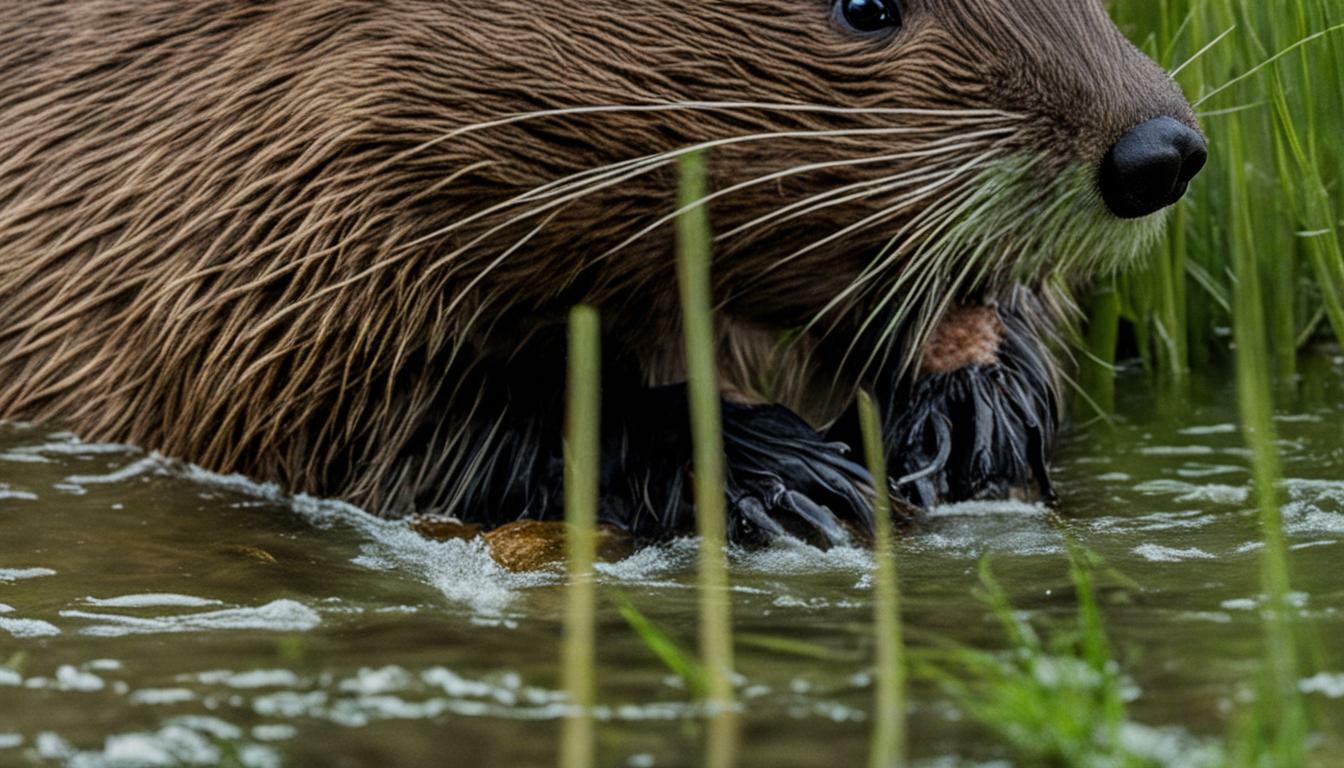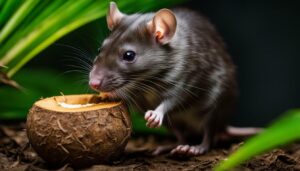If you’ve ever wondered whether beavers eat grass, you’re about to find out! Beavers are fascinating creatures with unique dietary habits.
While they do consume a variety of vegetation, including grass, their diet primarily consists of woody plants, bark, and aquatic plants.
Let’s explore the intricacies of the beaver’s diet and discover what makes them such efficient herbivores.
Key Takeaways:
- Beavers primarily eat vegetation such as twigs, foliage, bark, and aquatic plants.
. - They have a preference for woody plants, especially during colder months.
. - In the summer, they consume more aquatic plants and sedge plants.
. - Beavers also eat ferns, leaves, grasses, fruits, vegetables, fungi, and grains depending on food availability.
… - Despite being large rodents, beavers do not eat meat or fish.
Beavers’ Dietary Habits
Beavers are primarily herbivores, with a varied diet that includes a range of plant material. These industrious creatures have specific food preferences, depending on the availability and season.
Their diet consists mainly of twigs, foliage, bark, and aquatic plants.
During the colder months, beavers have a strong preference for woody plants, especially the inner bark of trees.
This preference is likely due to the higher nutritional value and abundance of woody plants during this time.
However, in the summer, their diet shifts towards consuming more aquatic plants and sedge plants.
Aside from woody and aquatic plants, beavers also consume other vegetation such as ferns, leaves, grasses, fruits, vegetables, fungi, and even grains.
Their dietary choices are influenced by food availability, as they adapt their feeding habits to ensure their survival.
Seasonal Adaptations
Beavers have fascinating seasonal adaptations when it comes to their diet. They modify their food preferences based on the changing seasons, allowing them to thrive in different environments. For example, during the colder months, they rely more heavily on woody plants and bark as a source of nutrition. In contrast, during the summer, they switch to consuming more aquatic plants that are abundant in their natural habitats.
| Season | Food Preferences |
|---|---|
| Winter | Woody plants and bark |
| Summer | Aquatic plants and sedge plants |
By adjusting their diets to the available resources, beavers can ensure a steady supply of food throughout the year.
This ability to adapt helps them survive in various habitats, making them highly successful herbivores in their ecosystems.
Woody Plants and Bark
When it comes to food, beavers have a particular fondness for woody plants and bark. These constitute a significant part of their diet, especially during the colder months. Beavers consume the inner bark of trees, which provides them with essential nutrients and helps keep their teeth in check.
The consumption of woody plants and bark is not only a dietary preference but also an important adaptation for beavers.
Their sharp incisors and strong jaws allow them to gnaw through the tough outer layers of trees, gaining access to the inner bark, which is more nutritious and easier to eat.
This adaptation also serves a purpose in their habitat as it helps create space for their lodges and dams.
| Food | Nutritional Value |
|---|---|
| Woody plants and bark | Provide essential nutrients and help maintain teeth |
| Aquatic plants and sedge plants | Rich in fiber and carbohydrates |
| Ferns, leaves, grasses, fruits, vegetables, fungi, and grains | Varies depending on availability, contribute to overall diet |
In addition to meeting their nutritional needs, the consumption of woody plants and bark allows beavers to shape their environment.
By felling trees and removing the bark, they create space for new growth, influencing the composition and diversity of the surrounding ecosystem.
Adaptations for Consumption
Beavers possess specialized dental anatomy that enables them to efficiently consume woody plants.
Their incisors have a hard enamel outer layer, allowing them to withstand the abrasive properties of chewing on bark and wood.
The constant growth of their teeth also compensates for wear and tear, ensuring their continued effectiveness.
Overall, the beaver’s diet is a reflection of its adaptability and resourcefulness. While woody plants and bark form a substantial part of their food sources, beavers also incorporate a variety of other vegetation into their diet to ensure their nutritional needs are met throughout the year.
Aquatic Plants and Sedge Plants
In the warmer months, beavers rely on a diet that includes plenty of aquatic plants and sedge plants.
These plants provide them with the necessary nutrients to thrive during this season. Aquatic plants such as water lilies and pondweeds are rich sources of sustenance for beavers, offering a combination of carbohydrates and proteins.
Sedge plants, including rushes and sedges, are also a staple in their diet, providing them with essential fiber and minerals.
Beavers are well adapted to life in the water and have developed specialized feeding behaviors to efficiently consume aquatic plants.
They use their front paws and strong jaws to break off sections of these plants, consuming them both above and below the water’s surface.
This allows them to access the most nutritious parts of the plants while minimizing the effort required to obtain their food.
While aquatic plants and sedge plants form a significant part of a beaver’s diet in the warmer months, their consumption varies depending on food availability and the specific habitat they inhabit.
Beavers are opportunistic feeders and will adjust their diet based on what is abundantly accessible. This flexibility allows them to adapt to different environments and survive in various conditions.
| Aquatic Plants | Sedge Plants |
|---|---|
| Water lilies | Rushes |
| Pondweeds | Sedges |
| Duckweed | Reeds |
Overall, beavers have a diverse diet that includes a wide array of vegetation, allowing them to meet their nutritional needs in different seasons.
Their ability to consume aquatic plants and sedge plants during the warmer months showcases their adaptability and resourcefulness in obtaining food.
Other Vegetation
Beavers have a diverse palate, feeding on various vegetation depending on what’s available in their environment.
Their diet extends beyond the woody plants and aquatic vegetation we discussed earlier. These resourceful rodents also consume ferns, leaves, grasses, fruits, vegetables, fungi, and grains.
Their ability to adapt their diet to the food available in their surroundings is key to their survival.
When vegetation is abundant, beavers enjoy feasting on a wide range of plant matter. They savor the greens of ferns and leaves, nibble on various grasses, and indulge in the sweetness of fruits and vegetables they come across.
They even have a taste for fungi, including mushrooms, and have been known to consume grains like oats and wheat.
To provide a comprehensive overview of the beaver’s diet, here’s a table summarizing the different types of vegetation they consume, including their preferences and seasonal variations:
| Type of Vegetation | Preference | Seasonal Variation |
|---|---|---|
| Ferns | Enjoyed | Available year-round |
| Leaves | Nibbled on | Abundant in spring and summer |
| Grasses | Consumed | Available year-round |
| Fruits and Vegetables | Indulged in | Abundant in summer and fall |
| Fungi | Enjoyed | Seasonally available |
| Grains | Occasionally consumed | Dependent on availability |
As you can see, beavers are not picky eaters when it comes to vegetation. Their diet diversifies based on what they can find in their surroundings, enabling them to adapt to different food availability throughout the year.
This dietary flexibility is crucial to their survival in various habitats.
No Meat or Fish
Contrary to their size and appearance, beavers have a strictly herbivorous diet and do not consume meat or fish.
These large rodents rely entirely on plant-based foods to meet their nutritional needs. By feeding on a wide variety of vegetation, beavers have adapted to survive in various environments and seasons.
One of the main components of a beaver’s diet is woody plants, including the inner bark of trees. During the colder months, when their preferred food sources are scarce, beavers rely heavily on the nutritious inner bark for sustenance.
They skillfully gnaw through the outer layers of trees using their sharp incisors, accessing the inner bark that serves as a vital food source.
In the summer, beavers shift their diet to include more aquatic plants and sedge plants. These plants thrive in wetland areas, which are the ideal habitat for beavers.
By consuming a variety of aquatic plants, they not only ensure a well-rounded diet but also contribute to the ecological balance of their ecosystem.
| Beaver Diet | Seasonal Preferences |
|---|---|
| Woody plants | Colder months |
| Aquatic plants and sedge plants | Summer |
Aside from woody and aquatic plants, beavers also consume ferns, leaves, grasses, fruits, vegetables, fungi, and grains, depending on food availability.
Their diet is diverse and adaptable, allowing them to thrive in different ecosystems. By taking advantage of the abundant vegetation in their surroundings, beavers can sustain themselves throughout the year.
In conclusion, beavers are remarkable creatures that have developed a specialized diet to meet their nutritional needs.
Although they may consume grass on occasion, their primary food sources are woody plants, bark, and aquatic plants.
By adhering to a herbivorous diet, beavers play a vital role in maintaining the balance of their ecosystem.
Seasonal Adaptations
Beavers’ feeding habits undergo seasonal adjustments to ensure their nutritional needs are met year-round.
These adaptations allow them to thrive in changing environments and maintain a balanced diet. Let’s explore how beavers adjust their feeding habits throughout the year.
Winter Feeding Habits
During the winter months, when food sources are limited, beavers rely heavily on woody plants. They utilize their powerful incisors to gnaw through tree bark and consume the inner bark, which is rich in nutrients.
This adaptation allows them to obtain essential nourishment when other vegetation is scarce.
Summer Feeding Habits
In the summer, beavers shift their diet to include a higher proportion of aquatic plants and sedge plants.
They venture into the water, where they can easily access and consume these plants. This change in diet is not only influenced by food availability but also by the increased nutritional benefits derived from the abundance of aquatic vegetation during this season.
| Season | Feeding Habits |
|---|---|
| Winter | Woody plants, inner bark |
| Summer | Aquatic plants, sedge plants |
General Diet Adaptations
Throughout the year, beavers also consume a diverse range of vegetation, including ferns, leaves, grasses, fruits, vegetables, fungi, and grains.
Their diet is influenced by food availability and their ability to source different types of plant matter based on their immediate environment.
This flexibility allows them to adapt to changing conditions and ensures a varied diet.
Beavers have uniquely adapted feeding habits that enable them to thrive in different seasons. These adjustments play a crucial role in meeting their nutritional needs and sustaining their overall health and survival.
Food Availability
Beavers are resourceful creatures that make use of available food sources and store provisions for times when food is scarce.
Their diet consists mainly of vegetation, but the specific types of plants they consume vary depending on their availability throughout the year.
During the colder months, when woody plants are more abundant, beavers have a preference for consuming the inner bark of trees.
This nutrient-rich food source provides them with the necessary sustenance to survive the harsh winter conditions.
In the summer, beavers shift their diet to include more aquatic plants and sedge plants. These types of plants are readily available in their habitat and offer the beavers a diverse range of nutrients.
These plants also help to supplement their diet when other food sources may be less abundant.
| Season | Food Availability |
|---|---|
| Winter | Woody plants and inner bark of trees |
| Summer | Aquatic plants and sedge plants |
In addition to their seasonal food choices, beavers also consume other vegetation, such as ferns, leaves, grasses, fruits, vegetables, fungi, and grains, depending on what is available in their environment.
This adaptability allows them to maximize their nutrition intake and thrive in a changing natural landscape.
Overall, beavers have a specialized diet that enables them to adapt to seasonal changes and survive in various habitats.
Their ability to find and utilize diverse food sources ensures their continued existence and the maintenance of their ecosystem.
Nutritional Benefits
A plant-based diet provides beavers with the essential nutrients they need to thrive in their habitat. By consuming a variety of vegetation, beavers are able to obtain the necessary vitamins, minerals, and fiber for their overall health and well-being.
One of the key nutritional benefits of their diet is the high fiber content found in woody plants, bark, and aquatic plants.
Fiber aids in digestion and helps regulate their metabolism, allowing beavers to efficiently break down and absorb nutrients from their food.
Vitamins and Minerals
Beavers also obtain a range of vitamins and minerals from their plant-based diet. Aquatic plants, in particular, are rich in nutrients such as calcium, iron, and vitamin A.
These essential elements contribute to their growth, development, and proper functioning of various bodily processes.
| Nutrient | Sources |
|---|---|
| Calcium | Aquatic plants |
| Iron | Aquatic plants |
| Vitamin A | Aquatic plants |
The consumption of a diverse range of vegetation also ensures that beavers receive a balanced mix of vitamins, including vitamin C, vitamin E, and various B vitamins.
These vitamins play a crucial role in supporting their immune system and overall vitality.
Energy and Sustenance
Beavers rely on their plant-based diet for the necessary energy to carry out their daily activities and maintain their body weight.
The carbohydrates found in plants serve as their primary source of energy, allowing them to power through the construction of dams, lodges, and other essential tasks.
Additionally, the rich array of vegetation provides beavers with sustenance throughout the different seasons.
Their ability to forage and store food ensures a constant supply of nutrients, even during periods of food scarcity or harsh weather conditions.
In conclusion, a plant-based diet is essential for the nutritional well-being of beavers. By consuming a wide range of vegetation, they are able to obtain the vital nutrients needed to support their growth, survival, and habitat modification behaviors.
Unique Adaptations
Beavers possess remarkable adaptations that allow them to consume a variety of plant material, including grass.
Their specialized dental anatomy and digestive system enable them to efficiently process and extract nutrients from vegetation.
One specific adaptation is their incisors, which are incredibly strong and continuously grow throughout their lives.
Their front teeth are perfectly suited for cutting through woody plants and bark, allowing them to access the inner layers of trees that make up a significant part of their diet.
These sharp incisors also enable them to neatly harvest grass and other types of foliage.
In addition to their robust teeth, beavers have a unique digestive system that helps them extract maximum nutrition from plant matter.
They possess large cecums, which are specialized pouches in their intestines where microbes break down cellulose.
This fermentation process allows beavers to digest tough plant materials, such as twigs and bark, that would be indigestible for many other animals.
| Adaptations | Function |
|---|---|
| Strong incisors | Cut through woody plants, bark, and grass |
| Large cecums | Facilitate fermentation of cellulose for digestion |
Conclusion
In conclusion, while beavers do consume grass, their diet is predominantly composed of woody plants, bark, and various types of aquatic vegetation.
Beavers are herbivorous animals that primarily feed on a variety of plant materials. They have a preference for woody plants, such as the inner bark of trees, especially during the colder months when other food sources may be scarce.
During the summer, beavers shift their diet to include more aquatic plants and sedge plants, taking advantage of the abundance of these types of vegetation.
They also consume a range of other plant materials, including ferns, leaves, grasses, fruits, vegetables, fungi, and grains, depending on the availability of food in their environment.
Despite being large rodents, beavers do not eat meat or fish. Their specialized diet allows them to adapt to different seasons and environments, enabling their survival in various habitats.
With their unique adaptations, such as specialized dental anatomy and digestive systems, beavers efficiently consume the plant material they need to thrive.
Overall, while grass is part of a beaver’s diet, it is just one component among many. Their diet primarily consists of woody plants, bark, and a wide range of aquatic vegetation.
By consuming these plant materials, beavers are able to meet their nutritional needs and sustain their population in their natural habitats.
FAQ
Do beavers eat grass?
No, beavers primarily eat a variety of vegetation, including twigs, foliage, bark, and aquatic plants. Grass is not their preferred food source.
What types of plants do beavers eat?
Beavers have a preference for woody plants, such as the inner bark of trees, especially during the colder months. In the summer, they consume more aquatic plants and sedge plants. They also eat ferns, leaves, grasses, fruits, vegetables, fungi, and grains depending on food availability.
Do beavers eat meat or fish?
No, despite being large rodents, beavers do not eat meat or fish. They have a specialized diet that consists of plant-based foods.
How do beavers adapt their feeding habits according to the seasons?
Beavers adapt their feeding habits by changing their diet preferences depending on the seasons. They consume more woody plants and bark during colder months and increase their consumption of aquatic plants and sedge plants in the summer.
How does food availability influence a beaver’s diet?
Beavers rely on food availability to make dietary choices. They have the ability to forage and store food to sustain themselves through periods of scarcity.
What are the nutritional benefits of a beaver’s diet?
Beavers derive important nutrients from their plant-based diet, which contribute to their overall health and survival. Specific nutritional benefits vary depending on the types of plant material they consume.
How do beavers efficiently consume plant material?
Beavers have unique adaptations that allow them to efficiently consume plant material. They possess specialized dental anatomy and a digestive system that enables them to break down and extract nutrients from vegetation.
Do beavers eat grass?
While beavers may consume grass, their diet primarily consists of woody plants, bark, and aquatic plants. Grass is not their main food source.




